After joining Rennes from Portuguese Liga NOS side Sporting CP last September, Raphinha was one of the most impressive members of Julien Stéphan’s side throughout the 2019/20 season.
According to Understat, the Brazilian playmaker had an ‘xGChain’ of 10.97 for the 2019/20 Ligue 1 season, which is the highest xGChain of any Rennes player from that term, with the next highest being Romain Del Castillo, whose xGChain was 7.96 last season. This statistic provides us with a calculation of the total xG of every possession that the player was involved in and Raphinha’s relatively high total indicates that he played an integral creative role for his side throughout the campaign.
In this tactical analysis piece in the form of a scout report, we will take an in-depth look at how Raphinha performed within Rennes’ tactics last season and we will try to identify some of the key traits and characteristics of the player that helped him to play an influential creative role for his side throughout the campaign, helping them to earn a place in next season’s UEFA Champions League, in this tactical analysis.
Positioning
Raphinha is a left-footed playmaker who can perform his role effectively on either wing or in a more central attacking midfield position. At times last season, he popped up on the left-wing, while he also played in the ‘10’ position on occasion during the 2019/20 campaign. However, the 23-year-old playmaker was primarily found on Les Rouge et Noir’s right-wing last season.
It may be fair to say that Stéphan was quite devoted to the 4-4-2 formation throughout the 2019/20 campaign. The 39-year-old coach set his Rennes side up in a 4-4-2 shape in 59.4% of their Ligue 1 fixtures last season. Only Angers, who utilised a 4-1-4-1 shape in 82% of their league games last season, utilised a particular formation in Ligue 1 during the 2019/20 campaign more often than Rennes utilised the 4-4-2 shape.
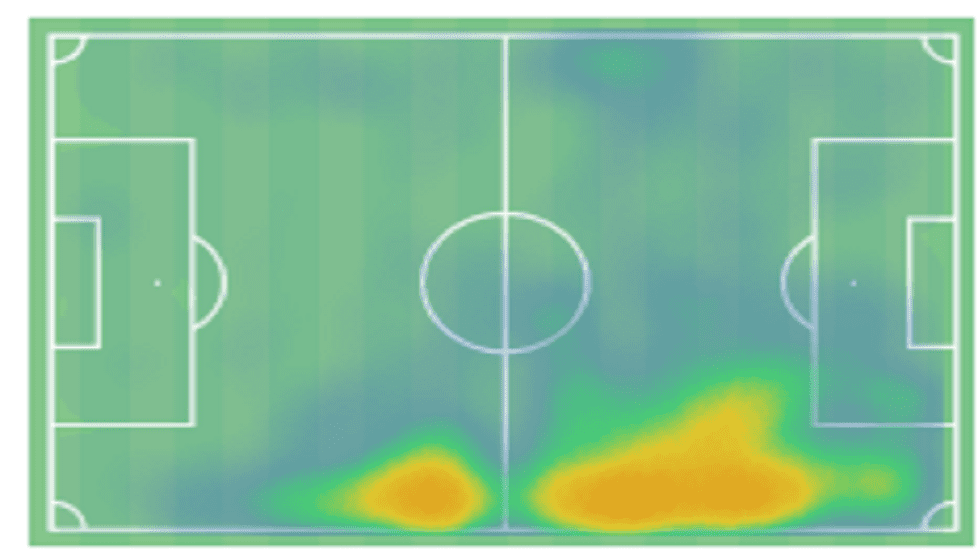
This image above shows us Raphinha’s heat map from the 2019/20 Ligue 1 season. This heat map provides us with an illustration which shows that while the playmaker did pop up on the left-wing on occasion, as well as drift into central areas of the pitch, he spent the vast majority of his time out wide on the right.
Within Rennes’ 4-4-2 shape this was a position that allowed the Brazilian to have a fairly significant creative influence over the game. While Benjamin Bourigeaud and Real Madrid-linked Eduardo Camavinga did offer Rennes some creativity from central midfield when they played there, a lot of Rennes’ creativity within the final third came from the wide positions.
With that in mind, it may not be too surprising to see that Raphinha, who generally featured on Les Rouge et Noir’s right-wing last season, and Del Castillo, who was quite often found on Rennes’ left-wing, finished the campaign with the highest xGChain of any Rennes players, as those two did undoubtedly bear a large amount of the creative workload for a Rennes side that played the second-fewest amount of through passes in Ligue 1 and the second-fewest amount of passes to the final third in Ligue 1 last season.
Dribbling
Raphinha attempted 6.55 dribbles per 90 last season for a Rennes side who attempted an average of 25.48 dribbles per game during the 2019/20 campaign. This means that the Brazilian playmaker attempted just over a quarter of his team’s dribbles per 90 last season and he successfully completed 43.2% of these dribble attempts.
Rennes completed an average of 52% of their dribble attempts on average, however, considering that Raphinha tended to operate in more advanced and more risky areas of the pitch, his dribble success percentage may still be quite impressive and this is an area of his game that he tends to utilise quite effectively to cause problems for opposition defenders.
One positive trait of Raphinha’s that helps him to perform as an effective dribbler is his impressive balance and agility. The Brazilian playmaker is capable of turning on a dime and this makes him a difficult man for opposition defenders to dispossess, while this also makes him a dangerous player to press aggressively as he is capable of dodging oncoming challenges by turning quickly on the ball and subsequently continuing to carry possession forward, leaving opposition defenders in his tracks.
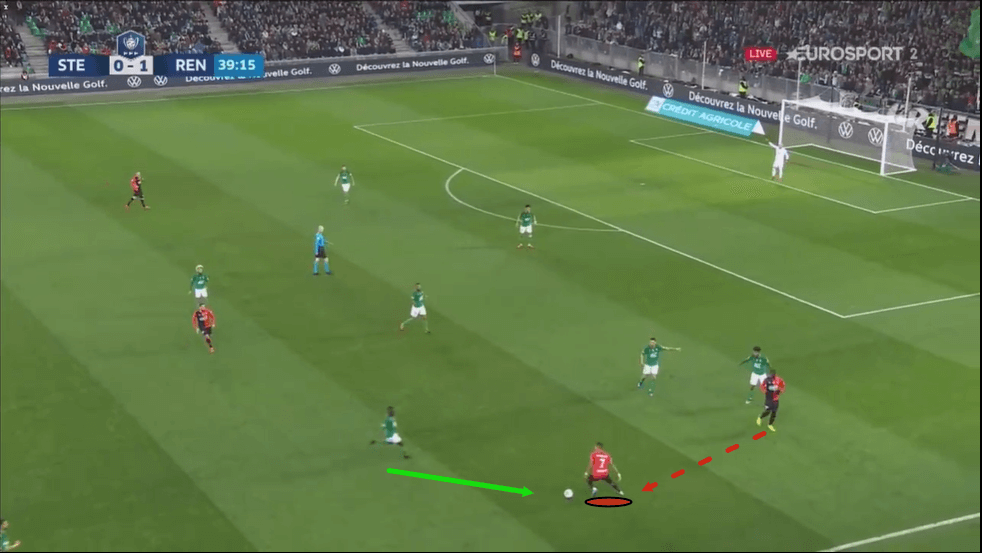
In this image above, Raphinha had just received possession from his teammate who we can see positioned just further up on the right-wing than him. After receiving possession, as we can see here, Raphinha turns to the outside where we can see an opposition midfielder beginning to close him down. Meanwhile, we can also see the rest of the opposition defence attempting to reorganise themselves into position here.
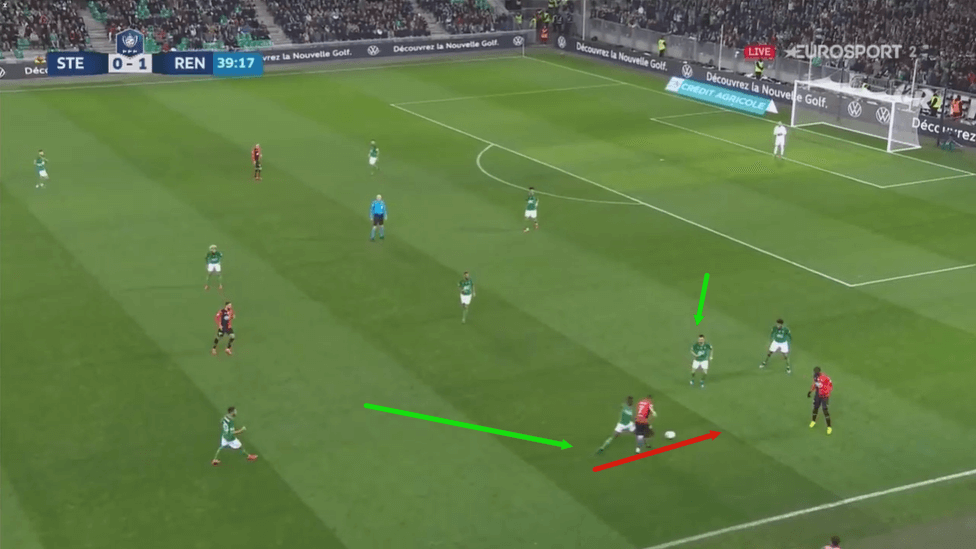
Raphinha bides his time and allows this midfielder to get closer to him before he quickly makes an agile turn on the ball and begins to carry it forwards towards the opposition’s last line of defence. As we can see, after Raphinha has turned and has begun carrying the ball forwards, the midfielder who had dropped back to press him ultimately ends up failing to steal possession from him.
This passage of play provides us with an example of how effective and dangerous Raphinha’s agility and balance can be. These two traits of his combine to help make him an effective dribbler. Within Rennes’ 4-4-2 setup, Raphinha can often find himself in 1v1 situations versus opposition defenders, at which point his dribbling ability becomes a particularly important element of his game. His agility and ability to quickly change direction like this while still moving at speed help him to perform this role effectively.
Raphinha’s agility and quality at turning quickly on the ball is useful for progressing into the final third from slightly deeper areas as this previous passage of play shows us, however, this element of his game is just as useful in more advanced areas of the pitch.
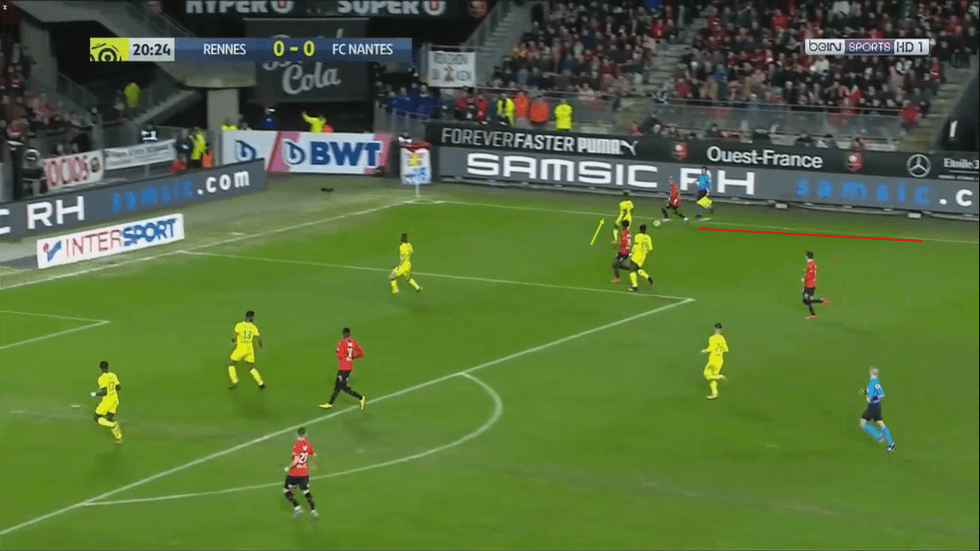
Here, we can see the playmaker in a slightly more advanced position than he was occupying in the previous passage of play. However, his goal during this passage of play is quite similar to the goal he had during the previous example. Raphinha is making his way down the right-wing here, sticking quite close to the byline. As he progresses along the right-wing in this manner, he eventually draws the nearest opposition player out to press him and this creates the tight 1v1 situation in which the playmaker thrives.
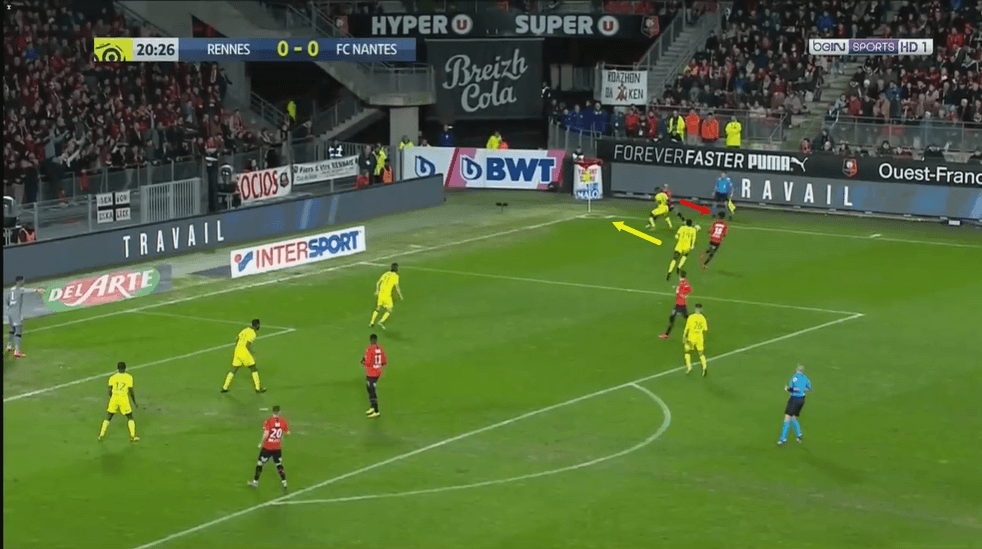
This next image shows us that the Brazilian makes his way all the way down the right-wing almost to the corner flag before the defender commits to making a challenge. However, as he eventually does so, Raphinha quickly flicks the ball back into the direction he came from and knocks it past the defensive player. Had he skipped past the challenge himself, this could have created an opening for him to break into the penalty area, however, on this occasion he is caught by the defender’s challenge and instead, he wins his side a free kick in an advanced part of the pitch.
This second passage of play shows us that the Brazilian’s agility and quality at quickly changing direction can be useful in a variety of different specific areas along the right-wing. His effectiveness in both deep and advanced positions on the right-wing makes him a useful player for his side to have positioned in that part of the pitch.
Within Rennes’ tactics, Raphinha does often end up playing the role of the player whose job it is to stretch the opposition’s backline by getting as wide as possible, which is illustrated by his heat map and which we saw an example of in the previous passage of play that we analysed.
However, he isn’t entirely predictable in that sense, as he does enjoy a degree of freedom to cut inside onto his favoured left foot from the right-wing at times to either play a cross via his favoured left foot from a deeper position on the right-wing or in the right half-space, to carry the ball inside in an attempt to play a defence-splitting through ball, or to work the ball into a potential shooting position which he could then try and take advantage of with his favoured left foot.
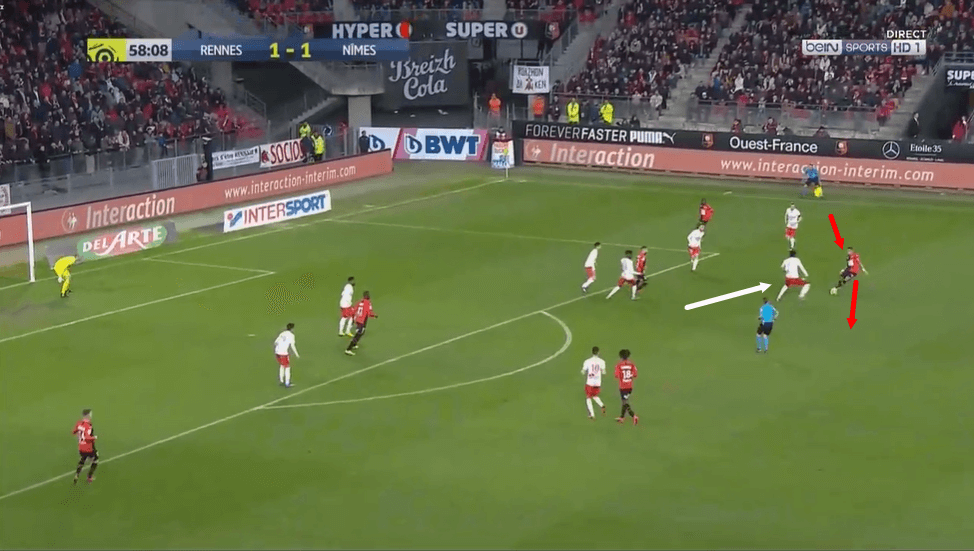
In this image above, we can see the playmaker in possession of the ball, drifting inside from the right-wing, working the ball onto his preferred foot. He keeps the ball in quite close proximity to his body as he shifts it to the inside of the pitch via the outside of his boot, retaining close control over the ball all of the time, while an opposition player begins to press him in an attempt to shut down his dribble attempt.
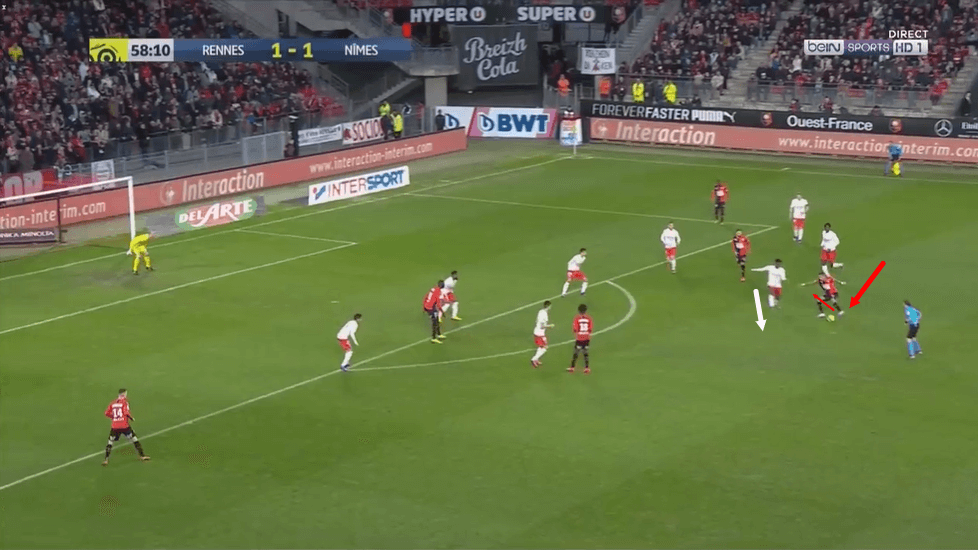
As play moves on, this second image shows us that after gliding past the defender that had approached him originally, Raphinha continues to move inside, pulling another opposition player out of his position in an attempt to close down his dribble in the process.
As this next opposition player moves out to try and put a stop to Raphinha’s run, the Brazilian begins to approach the ball as if he is going to attempt a long-shot and this results in the defensive player lunging out in an attempt to block what he predicts will be an incoming long-shot.
However, as we can see in this image, instead of attempting a shot, the 23-year-old Rennes man approaches the ball quite delicately in the end and uses the inside of his left foot to knock the ball back out towards the right. This movement, once again, shows us an example of Raphinha’s impressive ability to quickly and intelligently change direction at pace, to beat opposition defenders.
This passage of play also shows us that Raphinha can and does intelligently take advantage of the opposition’s knowledge of his stronger left foot when cutting inside and he is capable of faking out opposition defenders and creating an opening for himself to dribble past them by using their knowledge of his stronger left foot against them when they close him down in the way that we saw him do that in this passage of play.
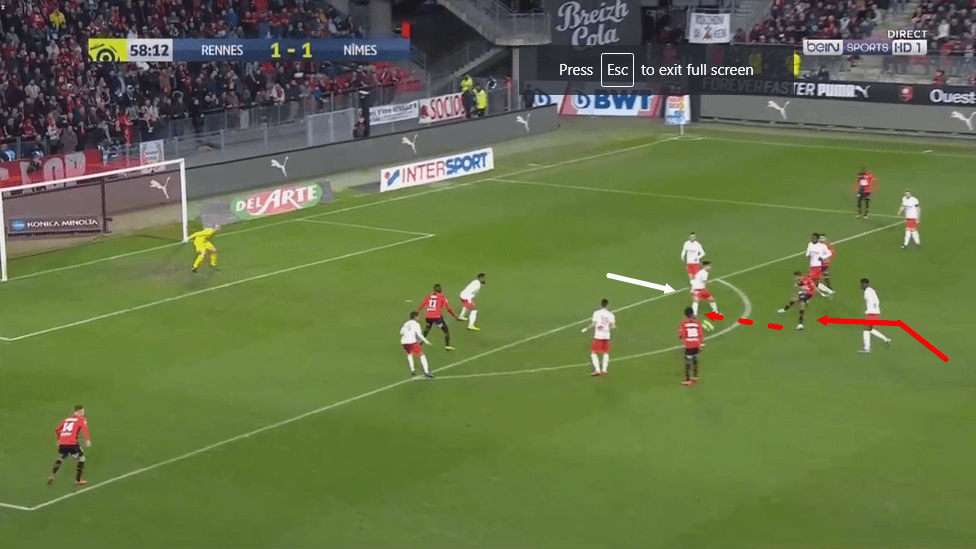
This next image shows us that this movement that we saw him pull off in the previous image did ultimately work and he does end up cutting back out onto his right foot and dribbling past that defensive player. Here, we can see that this ultimately leaves him situated between the two opposition defenders that we have seen him dribble past during this passage of play.
After beating the second defensive player, he brings the ball back onto his left foot and this time he does attempt a long-shot. Raphinha is comfortable with attempting shots from range in situations like this one where we can see plenty of opposition players around him and not a lot of space for him to move into.
On this occasion, Raphinha’s long-shot attempt is blocked, however, this passage of play shows us how effective the Brazilian’s dribbling quality can be when he decides to cut inside into a more central area of the pitch and onto his favoured left foot. He is capable of forging opportunities for himself in this manner, which shows us another dangerous element of his game.
The fact that he can perform effectively when carrying the ball along the right-wing or when cutting inside into a central area of the pitch gives opposition defenders plenty to think about and can add an element of unpredictability to his game.
Passing
As we previously touched upon, Rennes didn’t tend to play an incredible number of through passes or passes into the final third last season. A large amount of their creative workload fell to their wingers, who were generally Raphinha and Del Castillo. In addition to his dribbling, Raphinha’s passing ultimately ended up playing a significant role in Rennes’ creative process last season, as a result.
One might typically associate wide men with creating via crosses and Raphinha did attempt to create chances in this manner fairly frequently, playing 2.18 crosses per game in Ligue 1 last season. However, only 27.3% of his crosses reached their intended target, which may indicate that while he attempted to create chances in this manner, it wasn’t always the most effective form of chance creation for him and his side.
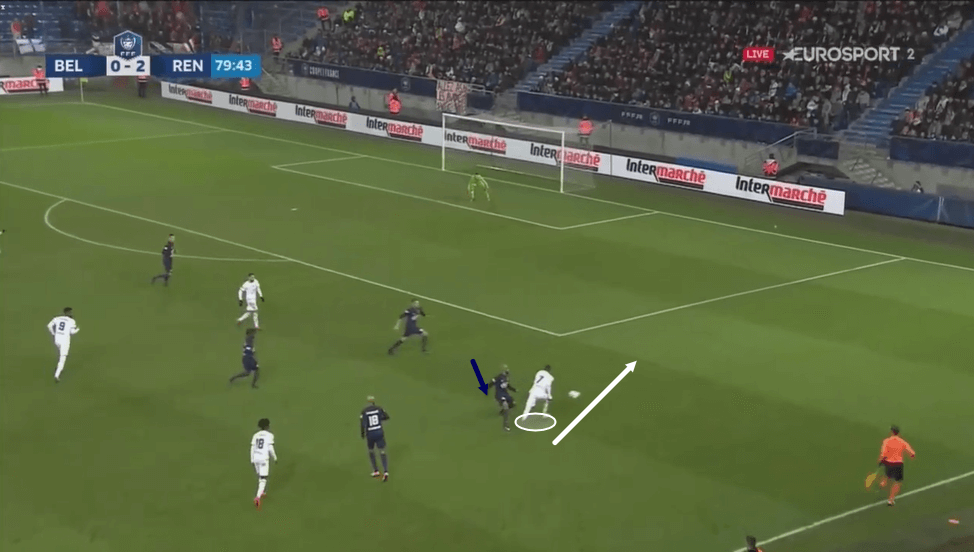
When Raphinha received possession out wide and managed to get into a 1v1 contest against an opposition defender, he often utilised the dribbling skills that we discussed previously to draw the man in and knock the ball outside of him, along the right-wing. The 23-year-old Brazilian would typically then drive down the wing towards the byline. We can see an example of the Brazilian playmaker doing this in the image above.
Just prior to this image being taken, Raphinha drew this defender towards him and baited him into lunging in to try and win the ball back. After the defender made his move, Raphinha glides past him and skips over the challenge. Then, he drove down the wing, towards the byline to get himself into a crossing position.
In addition to being a tricky dribbler, Raphinha possesses plenty of speed. He is a pacey player and he is capable of accelerating quite quickly which is another advantage for him in a scenario such as the one we can see in the image above, where he is required to utilise a burst of speed when the opposition defender does commit to making a challenge so that he can effectively beat him and carry the ball onwards into a more threatening position.
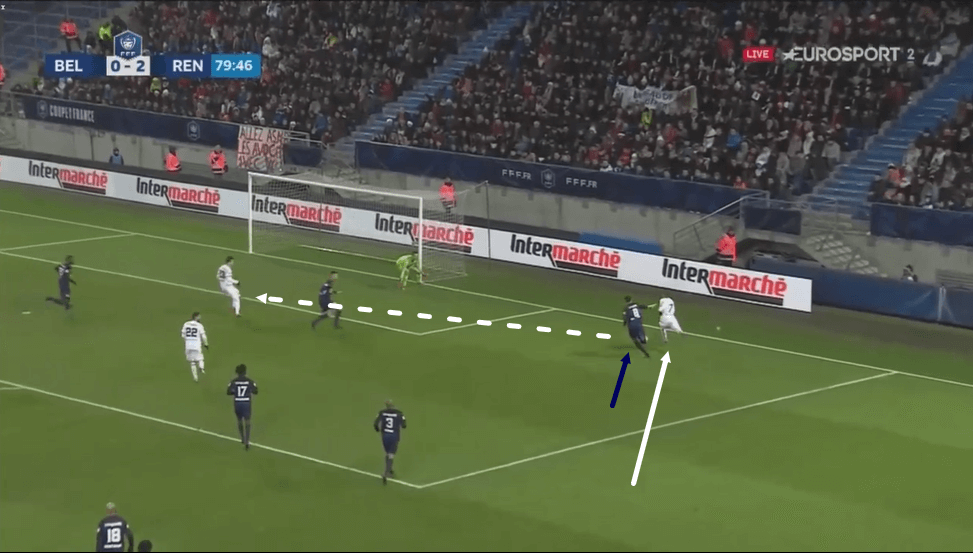
As this passage of play moves on, we can see that none of the opposition defenders ultimately end up catching up with Raphinha before he reaches the byline at which point he plays a low, hard cross into the box in an attempt to set up the centre forward who we can see has positioned himself right in front of the centre of the goal, just outside of the six-yard box.
Raphinha likes to drive all the way to the byline and carry the ball from his wide position into this sort of position near the byline but inside the penalty area. He often attempts to carry the ball into this position when carrying the ball down the wing.
Furthermore, we see the Brazilian utilise this type of low driven cross quite frequently from these positions. When he positions himself in a crossing position further away from the goal, he does, of course, tend to play his crosses into the box at a greater height and with less pace, however, this type of position, closer to the goal, is the one that he likes to occupy the most and as a result, this type of cross appears to be his favoured style of cross.
When this comes off, it can be difficult for the opposition to defend against, as when Raphinha plays the ball into the danger zone at such pace, and at a dangerous, low height, the slightest of touches can be enough to alter the ball’s direction and send it flying into the net. However, this type of cross and the amount of power he likes to put on it, can come at the expense of accuracy at times, which may explain why his cross success percentage is so low.
He also often has to play crosses with his weaker right foot in these scenarios which could also be a contributing factor to his low cross success percentage. Raphinha is quite two-footed and his comfortability with playing crosses with his right foot is a big part of why he was so effective and unpredictable on Rennes’ right-wing last season, however, he is still a left-footed player and, as a result, it mightn’t be too surprising that he has struggled to play many of his crosses accurately.
Raphinha, however, is a player who, in many ways with regard to both his dribbling and crossing, could be described as a ‘high-risk, high-reward’-type player and this provides another example of why that is the case.
Rennes’ tactics set them up to utilise quite an unaggressive and low, compact block without possession of the ball. Stéphan’s side made 50% of their ball recoveries within their own third of the pitch last season. Metz, who made 51% of their ball recoveries within their own third of the pitch, are the only team to have made a higher percentage of their ball recoveries inside their own third than Rennes did. Furthermore, Les Rouge et Noir made just 11% of their ball recoveries in the final third.
These stats indicate that Rennes tend to play quite passively without possession of the ball. They often allow the opposition to commit numbers forward and as a result, when they win possession back, they often have plenty of space to attack in behind the opposition’s last line of defence and their effectiveness at exploiting their opponents during the transition to attack makes them a dangerous side in this phase of play.
Raphinha tends to play quite an important role for his side during the transition to attack. As the opposition will typically have commited plenty of numbers forward during their previous attack, the men that they have left in defence will prioritise protecting the central areas of the pitch. This can result in Rennes’ wingers enjoying an increasingly large amount of space during these phases of play and Raphinha thrives in these situations thanks to his speed and his ability to carry the ball at pace.
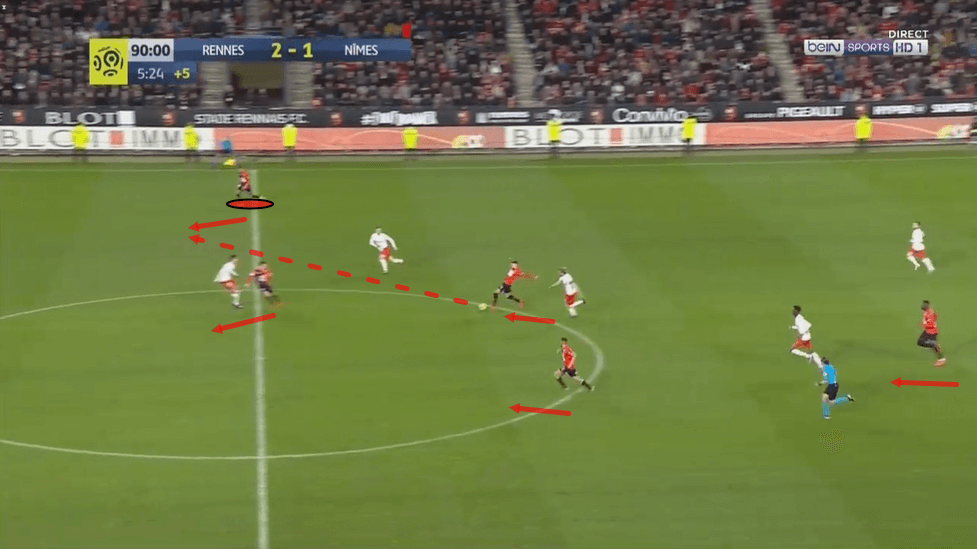
This image above shows us an example of Rennes driving forward on the counter-attack and here, we can see an example of the opposition defending in this manner, with a relatively low number of players left in defence, all protecting the centre of the pitch, while Les Rouge et Noir quickly create an offensive overload.
As the Rennes ball-carrier breaks through the centre, he spots Raphinha in space out on the right-wing, threatening to break in behind the opposition’s defensive line and the ball-carrier doesn’t think twice about playing the pacey Brazilian playmaker through.
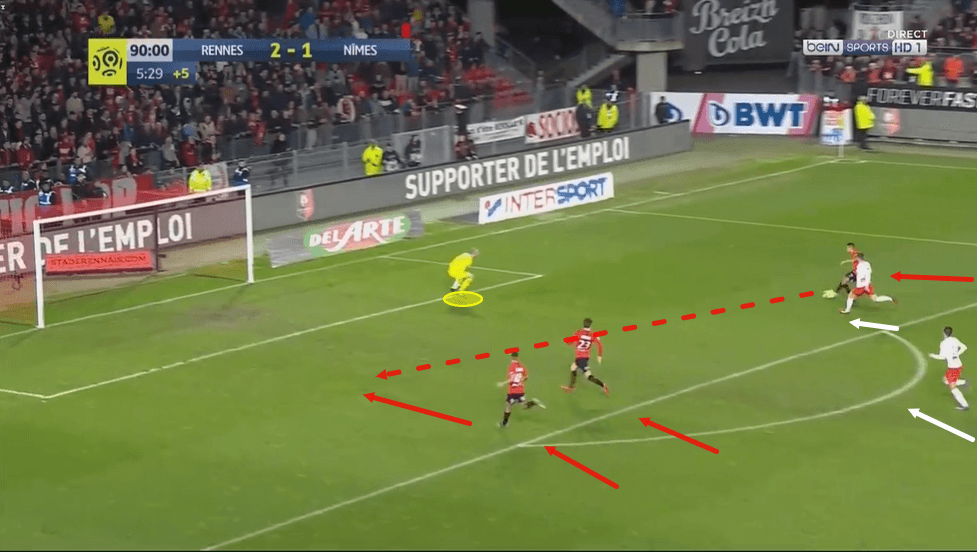
As play moves on, we can see that Raphinha, again, utilises his pace effectively in this passage of play and carries the ball all the way to the opposition penalty area without being caught. At this point, the Brazilian has the option of going solo, as he is essentially 1v1 with the goalkeeper here, or playing the ball across goal to one of the two free Rennes attackers in the penalty area.
Due to Rennes’ effectiveness on the counter-attack, Raphinha ended up in this type of situation on multiple occasions last season and, in general, he exhibited his high level of unselfish every time he did end up in these situations as a result of Rennes’ counter-attacking tactics, as he tended to play the ball across goal in an attempt to set up one of his teammates for an easy finish in the vast majority of these scenarios.
This particular occasion was no different and as play moves on here, Raphinha lays the ball across goal to find his teammate at the far post.
In addition to his effectiveness on the counter-attack, this passage of play shows us an example of Raphinha’s unselfish nature. The Brazilian is typically an unselfish playmaker and when he has the luxury of space and present teammates to play the ball to, he will generally try to find them before going it alone.
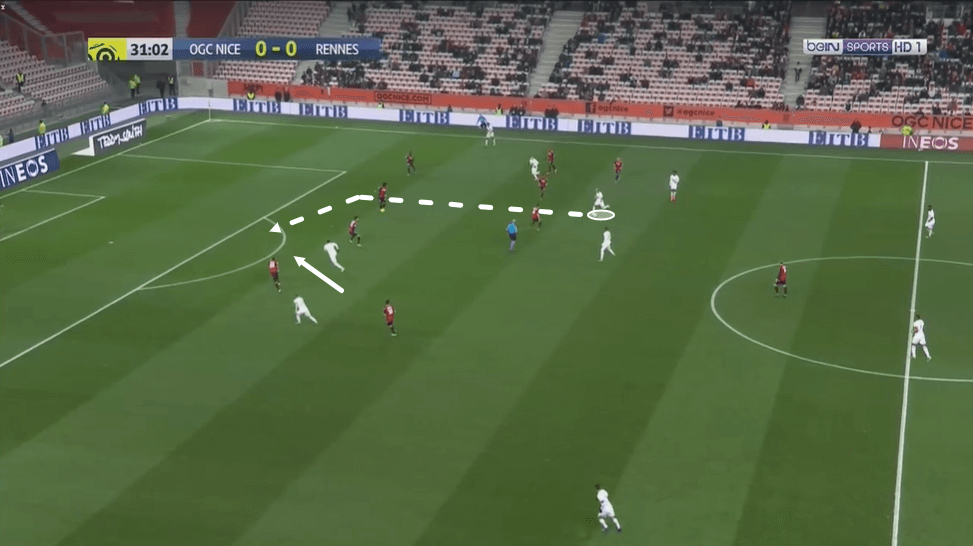
As well as being effective as a wide man and as a counter-attacking threat, we mentioned that Raphinha can operate effectively when cutting inside onto his favoured left foot from the right-wing and from a more central position. This next image shows us an example of how the playmaker can operate effectively in this type of scenario.
Here, we can see Raphinha in possession of the ball in a central position. The opposition’s last line of defence can be seen sitting just in front of their penalty area here, while their midfield line are pressing up a fair bit higher, with one midfielder, in particular, closing down the ball-carrier Raphinha quite closely.
However, the playmaker still manages to spot the run that his centre forward is beginning to make in a diagonal line in behind the opposition defence and despite being under pressure, he calmly lifts the ball over the opposition’s midfield and defensive lines to try and set this attacker up in a 1v1 against the opposition goalkeeper.
Firstly, this shows us the playmaker’s versatility and how he can operate effectively from a more central position. This passage of play, in particular, may show how Raphinha can be utilised effectively against defensive lines that are sitting in a deeper block than we saw in some previous examples and this may give us a glimpse of how effective he can be at performing the role of the playmaker whose job it is to unlock a disciplined opposition backline.
Raphinha’s passing quality played an important role for Rennes in a variety of different ways last season. The playmaker can cause the opposition problems with his passing when running in behind, or when given even a small bit of space in front of the defensive line, which makes him a difficult threat to deal with for plenty of defences.
Defensive contribution
Out of possession, all of Rennes’ players are required to put in a shift to some extent and Raphinha is no different. The defensive effort of Rennes’ midfield played an important role in helping Stéphan’s side to finish the season with the joint-second best defensive record in Ligue 1. Only Reims conceded fewer Ligue 1 goals than Rennes last season while league winners PSG are the only side who equalled Rennes’ impressive defensive record.
As we touched upon previously, Rennes generally defended quite passively, without forcing many turnovers in advanced areas of the pitch. This required Raphinha to play a role within Rennes’ deeper 4-4-2 defensive block quite frequently and his ability to learn and perform his role in Rennes’ defensive shape was important for his side, as one element of this shape not being up to par could have weakened the entirety of the structure, which, as is evident by their impressive defensive record from the campaign, ultimately wasn’t the case.
Raphinha engaged in a respectable 5.06 defensive duels per 90 last season, winning just over half of them with a 52.9% success percentage. The Brazilian also made a respectable average of 3.47 interceptions per 90 for a Rennes side that made an average of 36.75 interceptions per 90 in total, so it may be fair to say that the 23-year-old played his part in a successful defensive system quite effectively.
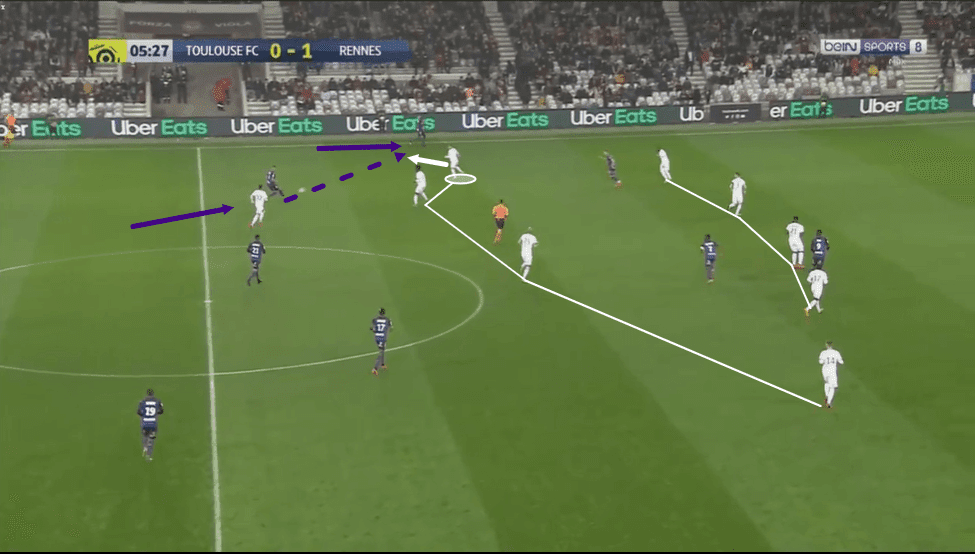
This image above shows us an example of Rennes’ 4-4-2 shape sitting in a mid-block out of possession. We can see how tight and compact the defensive line sits here, as the opposition play the ball out to Raphinha’s side of the pitch.
The opposition struggle to build-up effectively due to Rennes’ defensive tactics and as this player attempts to play the ball out to an advancing left-back, Raphinha jolts forward, stealing possession and creating an opportunity for his team to counter-attack, in the process.
This shows us a visual example of the role Raphinha typically plays in his side’s defensive tactics.
Conclusion
To conclude this tactical analysis piece in the form of a scout report, it’s clear that Raphinha played a significant role for Rennes during the 2019/20 campaign thanks to his playmaking ability. His dribbling quality, enhanced by his agility, balance, and ability to turn at pace, all helped him to perform effectively in the 1v1 situations he often found himself in on Rennes’ right-wing.
Meanwhile, Raphinha’s pace often helped him to break in behind the opposition’s defensive line and this was important for a Rennes side who thrived from counter-attacking situations last season.
Raphinha’s showcased a range of passing ability that allowed him to threaten the opposition defence from a variety of different positions and a variety of different in-game scenarios which made him a difficult playmaker to deal with for opposition defenders at times.





Comments